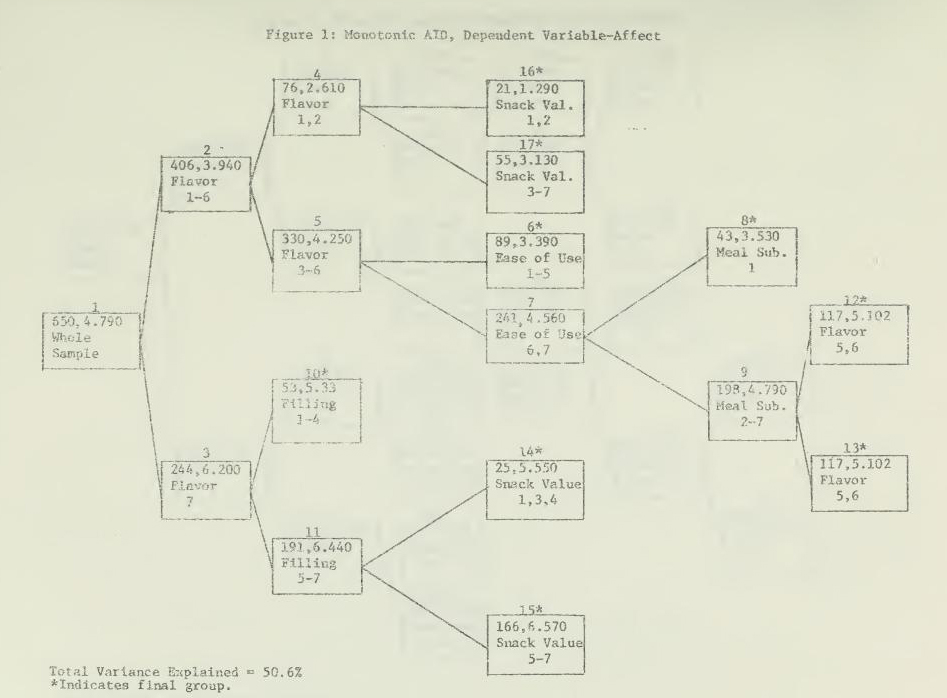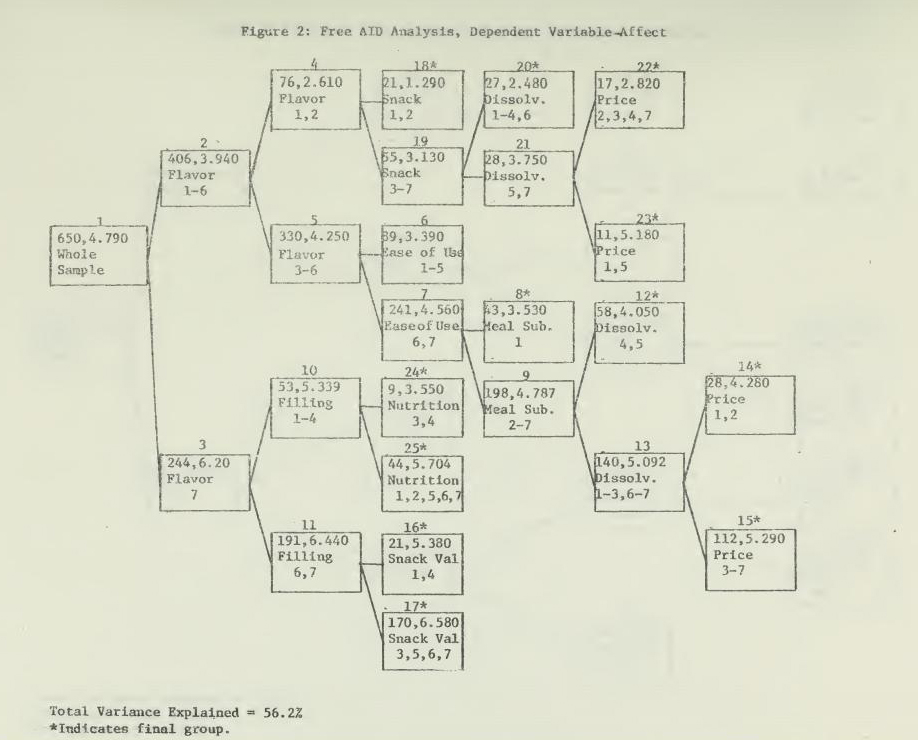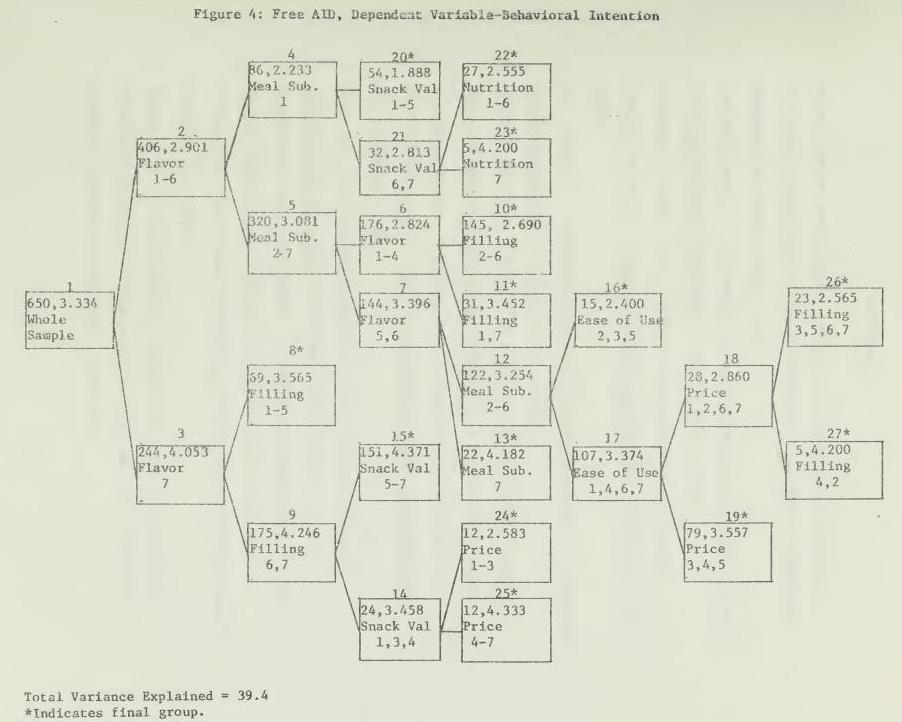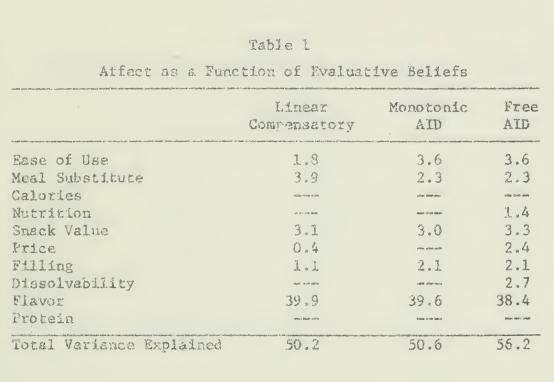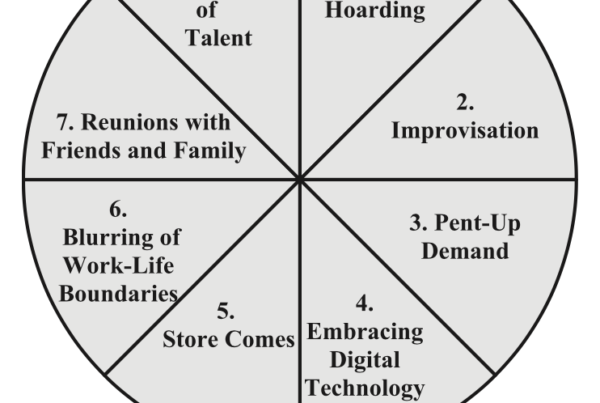P.S. Raju and Jagdish N. Sheth
Linear compensatory models of attitudes have been recently criticized by researchers on the grounds of both linearity and additivity assumptions inherent in them. This study empirically examines the predictive and structural impact of relaxing linearity and additivity assumptions in the analysis of the data.
There seems to be a general consensus among attitude researchers [4, 6, 7, 9, 13] that attitudes consist of one or more of these three elements: affect (like-dislike emotive tendency toward an object or concept); beliefs (cognitive profile related to the object or concept); and behavioral intention (response tendency of approaching or avoiding the object or concept). Furthermore, a number of researchers, both in social psychology and in consumer psychology, have theorized that there is a linear additive relationship between the beliefs, affect and behavioral intention components of attitudes. This is especially true of the popular expectancy-value models of attitude structure which linearly aggregate a profile of beliefs to create the cognitive component of attitudes [1, 3, 6, 9].
Recently, several researchers have expressed the concern that the linear additive presumption may be a serious limitation in our understanding of how attitudes structure and change. Many have suggested alternative ways with which beliefs may be related to affect or behavioral intention such as the conjunctive, the disjunctive, the lexicographic or the decision net types of relationships [4, 5, 10, 14, 15, 16]. Unfortunately, the different explanations given for different models of attitude structure have equally attractive and persuasive arguments so that it is difficult to rule out any one model based on deductive reasoning. What we need, therefore, is some experimental or empirical research which can compare the predictive and structural efficacy of different attitude models on a comparative basis. The study described in this paper is an empirical investigation of the structure of attitudes as linear additive, linear interactive and nonlinear interactive relationships between the beliefs and affect and the beliefs and behavioral intention components of attitudes.
Study Design
The alternative models to the linear additive model seem to raise two fundamental questions about the nature of relationship between beliefs, affect and behavioral intention: (1) Do beliefs really compensate for one another so that absence of a belief can be compensated by other beliefs in generating the same extent of affective or behavioral tendencies? Isn’t it possible that beliefs interact among themselves so that absence of any one belief can reduce affective or behavioral tendencies regardless of the nature of other beliefs? (2) Are beliefs linearly related to affective or behavioral tendencies which presumes a. monotonic increasing function, or is it more realistic to presume that the maximum relationship lies at the intermediate level which therefore presumes a nonmonotonic or curvilinear relationship?
Empirically, it is possible to examine the compensatory (additivity) and linearity assumptions with the use of the AID technique [11, 12]. Specifically, the monotonic All) tests the additivity assumption end free AID tests both the additivity and the monotonicity assumptions (8). Accordingly, it is possible to empirically compare the predictive and structural relationship of three broad classes of attitude models: the linear compensatory model with the use of multiple regression, the linear non- compensatory model with the use of monotonic AID, and the nonlinear-noncompensetory model with the use of free AID.
A usable sample of 650 homemakers had rated a convenience food product on 13 beliefs which were developed based on a prior depth interview study. In addition, the homemaker expressed her affect toward the product on a bipolar seven-point rating scale which ranged from “In general, I like it very much” to “In general, I don’t like it at all’. Her behavioral intention was measured on a five-point scale which asked the likelihood of her buying the product in the next month.
In order to avoid the problem of multicollinearity among beliefs to examine the structural relationship of each belief with affect and behavioral intention, a principal components analysis first was, performed on the 13 beliefs. Based on the results of factor analysis, due to their high degree of multi collinearity with other beliefs. The empirical investigation of three broad classes of attitude models is, therefore, limited to the ten beliefs which have low correlations among them. These low correlations also tend to minimize the order bias present in all stepwise procedures, including AID.
The linear compensatory model was tested by performing two stepwise multiple regressions with
affect and behavioral intention as the criterion variables respectively and the ten beliefs as the predictor variables. An F ratio of 3.85 corresponding to the 0.05 level of significance was set for a predictor variable to enter in the stepwise regressions. We also performed two monotonic AID analyses with affect and behavioral intention as the criterion variables respectively and the ten beliefs as the predictor variables (Figure 1 and 2). In order to avoid instability of the marginal branches due to relatively small sample size in AID, the criterion of split reproducibility was set of 0.9 percent instead of the normal 0.6 percent criterion. Finally, we performed two Free AID analyses on the same criterion and predictor variables (Figures 3 and 4).
Results and Discussion
The results of three separate analyses of affect and behavioral intention comparable to linear compensatory, linear noncompensatory and nonlinear noncompensatory models of beliefs are summarized in Tables 1 and 2. Beliefs, in general, tend to correlate more strongly with affect than with behavioral intention which i consistent with prior thinking and research [6, 9, 13]. A closer examination of the amount of total variance explained by the three general classes of models also suggests that the linearity assumption is more restrictive than the additivity assumption. In other words, beliefs may compensate for one another but the relationship between beliefs and affect or behavioral intention is not necessarily monotonic. The free AID tree diagrams in Figures 3 and 4 clearly indicate that this is especially true of the beliefs called nutrition, price and dissolvability when relating them to affect, and of beliefs called price and filling capability when relating them to behavioral intention.

Even though the monotonic noncompensatory model does not explain more variance in affect compared to the linear additive model, it is interesting to note that the relative contributions of the beliefs do not remain the same under the two models. In shout, it is advantageous to examine noncompensatory relationships because they may provide different substantive interpretations for at least some of the total beliefs.
Perhaps the most important conclusion that can be drawn from the results of comparative analyses is this: different beliefs may be differently related to affect or behavioral intention so that some beliefs are only linearly related while others are nonmonotonically related, and some beliefs may compensate for others while other beliefs may have synergistic effects. In short, it is a moot question as to whether linear compensatory models are inferior to other types of models. Empirically, it is best to presume as little as possible about the nature of relationship between beliefs and affect or behavioral intention, and therefore utilize analytical strategies which are least restrictive in their presumptions. Since free AID permits both linear and nonlinear relationship as well as compensatory and noncompensatory relationship of each belief with affect or behavioral intention, it constitutes the least restrictive and most general analytical strategy. With its use, the researcher then can determine which specific type of relationship exists between beliefs and affect or behavioral intention in his specific study.
References
Frank M. Bass, and William L Wilkie. “A Comparative Analysis of Attitudinal Predictions of Brand Preference.” Journal of Marketing Research, 10 (August 1973), 262-9.
James R. Bettman. “Information Processing Models of Consumer Behavior,” Journal of Marketing Research, 7 (August1970). 370-6.
Gilbert A. Churchill Jr. “Linear Attitude Models: A Study of Predictive Ability,” Journal of’ Marketing Research. 9 (November 1972) 423-6.
George S. Day. “Evaluating Models of Attitude Structure,” Journal of Marketing Research, 9 (August 1972),
279-86.
Hillel J, Einhorn, “The Use of Nonlinear. Noncompenssatory Models in Decision Making,” Psychological Bulletin, 73 (March 1970),22I-30.
Martin Fishbein, “Attitude and the Prediction of Behavior.” in Martin Fishbein. ed.. Readings in Attitude Theory and Measurement. New York: John Wiley & Sons, 1967.
D. Katz. The Functional Approach to the Study of Attitudes,” Public Opinion Quarterly. 24 (Summer 1960), 163-204.
A. M. Roscoe and J. N. Sheth. “Demographic Segment tion of Long Distance Behavior Data Analysis & Inductive Model Building.” Proceedings. Third Annual Conference, Association far Consumer Research Chicago. 1972. 258-78.
J. N. Sheth. “A Field Study of Attitude Structure and Attitude Behavior Relationship,” Faculty Working Paper No. 116. College of Commerce, University of Illinois, Jul) 1973.
— and P. S. Raju. “Sequential and Cyclical
Nature of Information Processing Models in Repetitive Choice Behavior,” Proceedings. Fourth Annual Conference, Association for Consumer Research, Boston, 1973.
John A. Sonquist, Elizabeth U. Baker and James N. Morgan. Searching for Structure. Institute (or Social
Research. University of Michigan. Ann Arbor, 1973.
— and James M. Morgan. The Detection of Intersection Effects. Survey Research Center. Monograph No. 35, Institute for Social Research, University of Michigan. 1964.
H. A. Triandis. Attitude and Attitude Change. New York: John Wiley and Sons. 1971.
William L. Wilkie, and Edgar A. Pessemier. “Issues in Marketing’s Use of Multisttribute Attitude Models,” Journal of Marketing Research. 10 9November 1973), 428-41.
Frederick W. Winter. “Mathematical Considerations in the lisa of Linear Attitude Models,” Proceedings. Third Annual Conference, Association (or Consumer Research, Chicago, 1972,790-5.
Peter L Wright. “Consumer Judgment Strategies: Beyond the Compensatory Assumption.” Proceedings. Third Annual Conference. Association for Consumer Research, Chicago. 1972.316-24.
—. “The Simplifying Consumer: Perspectives on Information Processing Strategies,” paper presented at the AMA Doctoral Consortium, Michigan State University, East Lansing, August 1973.


